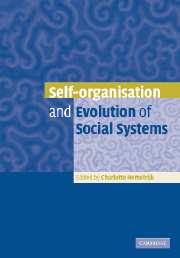Book contents
- Frontmatter
- Contents
- List of contributors
- Preface
- Introduction
- 1 From unicellular to multicellular organisation in the social amoeba Dictyostelium discoideum
- 2 Optimality of communication in self-organised social behaviour
- 3 The interplay of intracolonial genotypic variance and self-organisation of dominance hierarchies in honeybees
- 4 Traffic rules of fish schools: a review of agent-based approaches
- 5 A process-oriented approach to the social behaviour of primates
- 6 Order and noise in primate societies
- 7 Self-organisation in language
- 8 Dictatorship effect of majority rule in voting in hierarchical systems
- 9 Natural selection and complex systems: a complex interaction
- 10 Interlocking of self-organisation and evolution
- Index
- References
4 - Traffic rules of fish schools: a review of agent-based approaches
Published online by Cambridge University Press: 07 December 2009
- Frontmatter
- Contents
- List of contributors
- Preface
- Introduction
- 1 From unicellular to multicellular organisation in the social amoeba Dictyostelium discoideum
- 2 Optimality of communication in self-organised social behaviour
- 3 The interplay of intracolonial genotypic variance and self-organisation of dominance hierarchies in honeybees
- 4 Traffic rules of fish schools: a review of agent-based approaches
- 5 A process-oriented approach to the social behaviour of primates
- 6 Order and noise in primate societies
- 7 Self-organisation in language
- 8 Dictatorship effect of majority rule in voting in hierarchical systems
- 9 Natural selection and complex systems: a complex interaction
- 10 Interlocking of self-organisation and evolution
- Index
- References
Summary
Introduction
Perhaps no other group of organisms typifies emergent pattern as a function of the collective as well as schools of fish. Ranging in numbers from tens to millions, across all aquatic environments, trophic levels, and phylogenetic groups, fish schools are a quintessential biological model of collective action because: (1) the range of group pattern and behaviour appears to retain fundamental similarities across taxa, suggesting underlying mechanism, and (2) individuals are clearly not related to each other, as are social insects, and therefore pattern can not be simply explained by kinship altruism. Thus, schooling remains both a fundamental biological phenomenon, and a mystery. This chapter explores agent-based approaches to the study of fish schooling, with an eye towards synthesizing approaches and findings to date, and examining the degree to which synthetic results match data collected from real schools.
Specifically we will: (1) discuss emergence versus epiphenomena in the context of the individual, the group and the population; (2) review the major agent-based approaches to the study of fish schooling, with an in-depth examination of the ‘traffic rules of fish schools’; (3) compare simulation and model output to positional data collected on fish in real schools; and (4) suggest future directions for the study of fish schooling.
Emergence versus epiphenomena
We begin with a caveat: the majority of studies on fish schooling to date have centred on the question of why fish school, that is, the proximate and ultimate mechanisms behind the evolution of schooling behaviour (Pitcher and Parrish 1993).
- Type
- Chapter
- Information
- Publisher: Cambridge University PressPrint publication year: 2005
References
- 11
- Cited by



